Off-roading

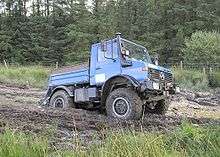
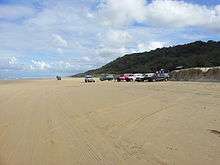
Off-roading is the activity of driving or riding a vehicle on unsurfaced roads or tracks, made of materials such as sand, gravel, riverbeds, mud, snow, rocks, and other natural terrain.
Off-road vehicle
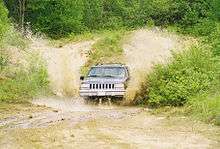
Traveling on off-road terrains require vehicles capable of accommodating off-road driving such as ATVs. These vehicles accommodate off road conditions with extended ground clearance, off-road tires and drive-train. Some manufacturers offer vehicles specifically meant for off-road use.
Recreational off-roading
Some examples of recreational off-roading include the following:
Dune bashing
Dune bashing is a form of off-roading on sand dunes.
A Large sport utility vehicle such as the Toyota Land Cruiser is an example of vehicle used (however, light weight vehicles often fare better in the extremely soft sand found on sand dunes). Vehicles driven on dunes may be equipped with a roll cage in case of an overturn; Similar to auto-racing, experience and skill is required to maneuver the car and prevent accidents. Before entering the desert in an everyday-use SUV or pickup, it is essential to reduce the tire pressure. This is done to gain more traction by increasing the footprint of the tire and, therefore, reducing the ground pressure of the vehicle on the sand as there is a greater surface area (much like a person wearing snowshoes can walk on a soft surface without sinking, but a person without them cannot). For example, tires with a recommended pressure of 35 psi would be reduced to approximately 12-14 psi.
A common modification is to fit beadlock rims, which allow tire pressure to be lowered even further, without risking tire and rim separation. Upon entering the desert, it is common to meet with a pack of vehicles and a group leader before proceeding. The group leader then leads the pack through the stunts in single file. The main reason for this technique is to prevent vehicles from losing track of direction and getting lost.
Cross-country
Unlike stationary dune bashing that tends to revolve around a single star dune or one obstacle, cross-country off-roading is an activity that lasts several days on routes with desert or other terrains. Routes in Africa generally have obstacles in largely uninhabited and uncharted terrain. These circuit routes are over 50 km and usually around 300 km long
Raid
This is a type of travel undertaken with a 4x4 that mostly goes over tracks and contains some bits of off-roading. Traditionally these trips are going through relatively uninhabited areas. Popular are the deserts in Tunisia, Morocco and other North African countries, continent crossing trips through Africa, trips through Mongolia or Northern Scandinavia. Typical modifications to vehicles for this kind of travel are the addition of extra fuel tanks, roof rack tents, and elaborate storage systems in the back for food, water/drinking, spare parts, tools and other cargo. Due to the extra weight the suspension is often reinforced with stronger springs, shock absorbers etc...
Green laning

Green laning (or two-tracking) is a leisure pursuit, generally suitable for any four-wheel-drive vehicle, even those without modifications or additional equipment. The term green lane refers to the fact that the routes are predominantly along unsurfaced tracks, forest tracks, or older roadways that may have fallen into disuse. In the UK they are usually roads which are not maintained in any way and will often include fords.
Mudding

Mudding is off-roading through an area of wet mud or clay.[1] The goal is to drive through as far as possible without becoming stuck.[2] There are many types of tires that are recommended for this activity. Some tires are balloon tires, mud-terrain tires and paddle tires. This activity is very popular in the United States, although it is illegal on public land due to the environmental impact.[3]
Rock crawling
Rock crawling is a category of off-roading. Vehicles used for rock crawling are usually modified with different tires, suspension components that allow greater axle articulation, and changes in the differential gear ratio in order to obtain characteristics suitable for low speed operation for traversing obstacles. It is common for a rock crawler to have a "spotter", who is an assistant on foot by the vehicle to provide information to the driver about the areas out of sight to the driver.
Rock racing
Rock Racing is very similar to rock crawling in the fact that the vehicles are driven over rocks, the difference is that there are no penalties for hitting cones, backing up or winching as is done in rock crawling. Rock racing also involves a degree of high-speed racing not seen in typical rock crawling.
Competitive trials
All progress is made at low speed and the emphasis is on skill, rather than finishing first although trialing can be highly competitive. There are three traditional forms of off-road trailing.
RTV trialing
RTV (Road Taxed Vehicle) trialing is the most common form of trialing. As the name suggests, it is for vehicles that are road-legal (and thus required to pay vehicle excise duty). This excludes vehicles that are highly modified or specially built. RTV-class vehicles can carry a wide range of suspension modifications, as well as off-road tires (provided they are road-legal), recovery winches, raised air intakes etc. Vehicles on RTV trials are usually best described as "modified from standard"—they use the standard chassis, drive-train and body that the vehicle was built with. Whilst modification is not necessarily required for an RTV trial, at the very least the vehicle would be expected to have some under-body protection such as a sump guard, differential guard and solid sills. RTV courses are intended to be non-damaging and driven at little more than a walking pace and a course properly laid out would be drivable without damage. However, the terrain usually includes steep slopes, water, side-slopes, deep ruts and other obstacles that could potentially damage a vehicle if mistakes are made or poor driving technique is used, and vehicle modifications increase the chance of success.
RTV trials usually take place on farmland, a quarry site or at a dedicated off-road driving center, and are usually organized by a dedicated trialing body (such as the All Wheel Drive Club or The Association of Land Rover clubs in the UK), or by a vehicle owner's club. The course consists of 10 to 12 "gates" marked by two garden canes, vertically placed. The gates are just wide enough to get a standard vehicle through. One vehicle attempts the course at a time, and is deemed to have cleared a gate if at least one of the front wheel hub passes between the canes. The vehicle's attempt ends when it comes to a stop (depending on the exact level of skill the trial is aimed at, any stopping may end the attempt, or a few seconds may be allowed). Long-wheelbase vehicles are usually allowed to perform a three-point turn if needed, providing the driver declares where the turn is going to be made before they attempt the course (this puts a strong emphasis on ground-reading ability). This can also be called a "shunt" where the driver has to attempt a gate and then shout shunt. they are then allowed a space of 1 and a half car lengths to reverse and line the car better to enter through the gate
The course between the gates is a "section": between the start line and the first gate is "Section 1", the part between the first and second gates is "Section 2" and so on. An RTV course is often laid out so that each section is progressively more difficult, although this is not always the case. If a driver fails to complete Section 1 they are given 10 points. If the attempt ends in Section 2, 9 points are awarded etc. A clear round results in gaining only 1 point. A day's event will consist of many different courses and the driver with the lowest score is the winner.
Since the terrain covered in RTV trials should be well within the capabilities of any reasonably capable vehicle (even in standard form), these trials place the emphasis on driver skill and ground-reading abilities. A good driver in a standard specification vehicle can easily win over a modified, highly equipped vehicle driven by a less competent driver.
CCV trialing
Cross Country Vehicle (CCV) trialing is the next step up from RTV trialing and is open to non-road-legal vehicles, which greatly increases the scope for modification. The terrain covered will be of greater difficulty than that found on an RTV trial, and will usually require more judicious use of speed to get the vehicle across certain obstacles, so increasing the risk of vehicle damage. Whilst no trial is intended to be vehicle-damaging mistakes and accidents are inevitable. A standard-specification vehicle would not be expected to be able to complete a CCV course.
The event is run along the same lines as RTV, with a course made up of cane-marked gates. The rules are also the same as an RTV trial.
CCV trialing differs greatly from RTV trials in the vehicles used. Since "anything goes", CCV trials rely on having the correct vehicle to a much greater extent than in an RTV trial. Competitors are able to design and build vehicles that are much more optimized for off-road use than in the lower ranks of trialing. CCV vehicles have powerful engines, high ground clearance, light, minimalist bodywork and good approach and departure angles. For many years, in the UK, the ultimate CCV vehicle could be built by taking the chassis of a Range Rover, removing the body, cutting the chassis down to an 80-inch wheelbase and mating it to the body of a Series I Land Rover, retaining the Range Rover's V8 engine and coil-spring suspension in a light, easy to maneuvre body. In recent years the value of early Land Rovers and Range Rovers has risen to the extent that this is no longer practical. CCV triallers now usually base their vehicles around Land Rover 90s or a standard 100-inch chassis from a Range Rover or Series I Discovery. The Suzuki SJ series of vehicles also make good bases for CCV-spec vehicles. Some vehicles are specially built, taking the form of light "buggies" with tractor tires and "fiddle" brakes for the best performance.
Vehicles are required to meet certain safety regulations. Roll-cages must be fitted and be built to a suitable standard, recovery points must be fitted front and rear and fuel tanks must meet certain standards. A 4-point harness for all occupants is required and a fire extinguisher is recommended.
Punch & winch challenge
A competitive form of trialing with a course laid out with control points or gates and vehicles must collect punches (holes on a punch-card) or traverse as many gates as possible. These challenges often include a small number of special stages.
At its most basic a winch challenge vehicle will be a CCV-spec machine with a front-mounted recovery winch. However, a distinct breed of vehicles adapted for Winch Challenges has evolved. The small, open-topped CCV vehicles are not well suited to carrying the often large range of equipment needed for winch recovery in difficult terrain. A larger vehicle with some form of protection from the elements is desired (the short-wheelbase Land Rover Defender, especially in "Hard Top" guise, is a typical and common basis for a Winch Challenge vehicle).
Other forms
There are other forms of trialing, usually based around one of the above types but with a slight difference. These are often used as more "fun" events within a vehicle club, rather than as a part of a formal championship. Examples include:
- Punch-Card Challenge. Usually based around an RTV trials course. Instead of a series of gates around a fixed course, a number of single canes are placed around a site. Each cane is numbered and a hole-punch tied to the cane. Each vehicle has a card with numbered squares marked on it. The card is tied to the exterior of the vehicle (usually from the wing mirror). The aim is to get the vehicle close enough to the cane so that the hole punch can be used to mark the appropriate square on the card. The punches usually use a pattern of pins to prevent one punch being used to cheat by punching a number of squares on the card. Unlike a trial course, the vehicle does not have to pass through a gate, it simply has to approach a cane and leave the cane. This tests driver skill and ground-reading, as the most obvious way to approach a cane is often not the easiest. For example, with a cane situated at the bottom of a steep slope it may turn out that the flat terrain at the base of the slope is too soft or muddy to drive over. The only way to the cane is to drive across the slope, stop (whilst the vehicle is tilted), punch the card and then continue. The winner is the driver who has collected the most punches.
- Tyro trial. The name derives from the Latin word "tyro" meaning "new recruit". "Tyro" trialing is intended as an introduction to the sport for newcomers or children and is the most basic level of trialing. These take the form of a course with gates, but the course is carefully laid out so that it requires definite skill to drive, but carries no risk of damage to the vehicle or injury to the driver. Vehicle modifications are not allowed. Some tyro trial organizers even ban the fitting of different types to tires to those the vehicle left the showroom with.
Winch events
Winch events often involve attempting to access areas that would be impossible without the use of a winch – this can include traversing deep gullies, steep slopes and so on. Most off-road vehicles that have been prepared for this type of event will typically have two winches, one at the front and one at the rear of the vehicle, each with a rated pull of over 9,000 lb (4,100 kg).
Off-roading events
In some countries off-road activities are strictly regulated, while others promote cross country off-road endurance events like the Dakar Rally, Baja 500 & 1000, Spanish Baja and the Russian Baja Northern Forest which are a test of navigation skills and machine durability. off road parks and motocross tracks also host a number of events and may be the only legal place to off-road in the area. Events include jamborees, rock crawling competitions, Mud Bog races, Top Truck Challenges and sand racing as well as many other events, such as the Tank Trap.
.jpg)
Russia has very busy off-roading championship 5-7 starts every year. Also every club has its own events, in Tambov off-road club Сhernozem has 4 traditional races and the most popular off-road race in Russia is Ladoga-race in Karelia.
Off-roading organizations
Organizations and associations participate in political lobbying supporting favorable regulations for off roading proponents. Some organizations, such as the Blue Ribbon Coalition and Tread Lightly!, are solely set up for off-roading related lobbying.
Vehicle modification
While production vehicles with off-road capabilities can travel on unsurfaced roads, modifications are needed to travel on terrains exceeding capabilities of original configuration. The following are some of modifications made for off-roading.
Vehicle lifts
A vehicle lift is when the vehicle is raised to increase the amount of clearance between the ground and the bottom of the body or frame of the vehicle. A lift will also help with tire clearance when going over large obstacles with only one or 2 wheels and allow the vehicles differential to flex without having the tires rub the insides of the fenders. There are several methods for vehicle lift. Some methods may be combined together to best fit the needs.
Body lift
This is a method that is only usable on body -on-frame design found in some pickup trucks and some SUVs. A body lift is performed by placed spacers in between the normal mounting points of the vehicle's chassis and body. These typically are between 1–4 inches. Any more than four inches (102 mm) will create a less sturdy set up. Raising the body permits the fitting of over-sized tires.
Suspension lift
suspension lift is a modification to vehicle's suspension system including springs, shock absorbers, controlling arms and steering linkage to raise the height.
Large tires
Increasing the tire size increases the ground clearance of all parts of vehicle including suspended components, such as the axles. It maybe necessary to make modifications to vehicle's suspension or body depending on the size of the tires to be installed and the specific vehicle.
Axle (clearance) lift
Portal axles, a type of axles with the axle line wheel centre allows increasing the ground clearance at differential cases without corresponding increase in overall vehicle height or the center of gravity.
Traction
Off-roading is always related to driving off the pavement, making it important to maintain proper traction in all road conditions such as mud, dirt, rocks, sand, ice or snow. It is recommended to use appropriate tires on each terrain type to get the most effective traction. Continuous track is often used in extreme road conditions when regular wheels can't provide enough traction for moving forward. Tracks may be used on sand, ices and snow.
Drive train
The drive-train characteristics determine the allocation of torque delivery from transmission to each powered axle end as their available traction change.
Some traction control devices used are:
- Locking differential [4]
- Limited-slip differential
- Four-wheel drive
Tires
Tires are often improved on off-road vehicles in order to better traverse rough terrain. Regular automotive tires don't provide enough traction to help a vehicle through sand, dirt, snow and ice, so specialized tires are normally used on off-road 4x4 vehicles. Large overall wheel diameter provides a better ride comfort and road clearance. Wide tires help to distribute the weight on sand, while narrower tires help get better traction in the snow or on ice. Each tire type has its own tread type to provide a proper grip in certain road conditions. Common off-road tire types are: Sand tires, Mud-terrain tyre, Snow tires and All-terrain tyre.
Dangers of vehicle lifting
While lifting a vehicle to gain ground clearance is helpful to off-roaders, it can also make a vehicle dangerous as, when a vehicle has been lifted, its center of gravity rises, which causes the vehicle to be more likely to tumble in certain situations. Other dangers include loss of visibility of smaller objects and bumper height as compared to other vehicles on the road. In the United States, bumper and frame height laws are effective in most states to ensure that the vehicles on the road are not too much higher than their average car counterparts.
Vehicle protection
A danger with off-roading is damage to the vehicle from hitting rocks or other hard surfaces on very uneven terrain. A typical solution would be to install skid plates (sometimes also called bash plates), which are thick metal plates protecting vulnerable parts (such as the transfer/gear box or engine oil sump). Some manufacturers install skid plates as standard equipment on some of their vehicles. For many others this additional protection is available as an after-market accessory. Skid plates may be simple flat plates, but they may also be formed (by stamping or by welding multiple pieces) to protect shaped items like differentials. Fuel tank skid plates are a common factory option.
Probably the most common improvement for off-road use is the grille or bull guard, which can be added with or without an improved bumper. These typically metal frameworks extend to protect the grille, and potentially the headlights as well. One common type used on off-road pickups and SUVs is the "prerunner" style, with an angular, protruding front designed to sweep vegetation away from the vehicle centerline, and to deflect the vehicle from less movable obstacles. The grille protection system can be assembled piecemeal, or a one-piece winch-mount bumper with a prerunner bar and grille guard can be fitted. Bumpers designed for off-road use typically have added eyes or D-rings to assist in vehicle recovery.
Another common off-roading accessory, "rock rails" or "rock sliders", are heavy metal rails or tubes which runs alongside the rocker panels and serves to protect the sides of the vehicle that are exposed on particularly rough terrain, or where there is a risk that lower edges of the vehicle between the wheels might come into contact with rocks below. This strategy can be extended to the entire vehicle, in which case it is referred to as an "external cage" or "exocage". External cages help protect the entire body of the vehicle in the case of a rollover or slide into an obstacle.
Criticism of ORV use
Environmental impact
Off-road vehicle use on public land has been criticized by some members of the U.S. government[5] and environmental organizations including the Sierra Club and The Wilderness Society.[6][7] They have noted several consequences of illegal ORV use such as pollution, trail damage, erosion, land degradation, possible species extinction,[8] and habitat destruction[9][10] which can leave hiking trails impassable.[11] ORV proponents argue that legal use taking place under planned access along with the multiple environment and trail conservation efforts by ORV groups will mitigate these issues. Groups such as the Blueribbon Coalition advocate Treadlightly, which is the responsible use of public lands used for off-road activities.
According to the U.S. Forest Service the use of old-style two-stroke engines, previously common in vehicles designed for off-road use, also causes concerns about pollution. This is because "two-stroke engines emit about 20 to 33 percent of the consumed fuel through the exhaust" (as the engine lubricant is a "total loss system" and is emitted by design) and "discharge from two-stroke snowmobile engines can lead to indirect pollutant deposition into the top layer of snow and subsequently into the associated surface and ground water".[12]
Noise pollution is also a concern[13] and several studies conducted by Montana State University, California State University, University of Florida and others have cited possible negative behavioral changes in wildlife as the result of some ORV use.[14]
Some U.S. states have laws to reduce noise generated by off-road and non-highway vehicles. Washington is one example: "State law requires off-road and other non-highway vehicles to use specified noise-muffling devices (RCW 46.09.120(1) (e) maximum limits and test procedures). State agencies and local governments may adopt regulations governing the operation of non-highway vehicles on property, streets, or highways within their jurisdiction, provided they are not less stringent than state law (RCW 46.09.180 regulation by local political subdivisions)".[15]
Mojave desert controversy
The U.S. Bureau of Land Management (BLM) supervises several large off-road vehicle areas in California's Mojave Desert.
In 2009, U.S. District Judge Susan Illston ruled against the BLM's proposed designation of additional off road use on designated open routes on public land. According to the ruling the BLM violated its own regulations[16] when it designated approximately 5,000 miles of off-road vehicle routes in 2006.[17] According to Judge Ilston the BLM's designation was "flawed because it does not contain a reasonable range of alternatives" to limit damage to sensitive habitat, as required under the National Environmental Policy Act.[18] Illston found that the bureau had inadequately analyzed the route's impact on air quality, soils, plant communities and sensitive species such as the endangered Mojave fringe-toed lizard, pointing out that the United States Congress has declared that the California Desert and its resources are "extremely fragile, easily scarred, and slowly healed".[18]
The court also found that the BLM failed to follow route restrictions established in the agency’s own conservation plan, resulting in the establishment of hundreds of illegal OHV routes during the previous three decades.[16] The plan violated the BLM's own regulations, specifically the Federal Land Policy and Management Act of 1976 (FLPMA) and the National Environmental Policy Act of 1969 (NEPA).[17] The ruling was considered a success for a coalition of conservation groups including the Friends of Juniper Flats, Community Off-road Vehicle Watch, California Native Plant Society, The Center for Biological Diversity, The Sierra Club, and The Wilderness Society who initiated the legal challenge in late 2006.[18]
Roadless area conservation
Many U.S. national parks have discussed or enacted roadless rules and partial or total bans on ORVs. To accommodate enthusiasts, some parks like Big Cypress National Preserve in Florida, were created specifically for ORVs and related purposes. However, such designations have not prevented damage or abuse of the policy.[19]
Public statements
In 2004, several environmental organizations sent a letter to Dale Bosworth, Chief of the United States Forest Service, and described the extent of damage caused by ORV use, including health threats to other people:
It is well-established that the proliferation of off-road vehicle and snowmobile use places soil, vegetation, air and water quality, and wildlife at risk through pollution, erosion, sedimentation of streams, habitat fragmentation and disturbance, and other adverse impacts to resources. These impacts cause severe and lasting damage to the natural environment on which human-powered and equestrian recreation depends and alter the remote and wild character of the backcountry. Motorized recreation monopolizes forest areas by denying other users the quiet, pristine, backcountry experience they seek. It also presents safety and health threats to other recreationists.[20]
In 2004 the Supreme Court Justice Antonin Scalia listed several problems that result from ORV use in natural areas. From the Environmental News Service article:
Scalia noted that off-road vehicle use on federal land has "negative environmental consequences including soil disruption and compaction, harassment of animals, and annoyance of wilderness lovers.[21]
A number of environmental organizations, including the Rangers for Responsible Recreation, are campaigning to draw attention to a growing threat posed by off-road vehicle misuse and to assist overmatched land managers in addressing ORV use impacts.[22] These campaigns in part have prompted congressional hearings about the growing impact of unmanaged off road vehicle use.
The House Natural Resources Committee Subcommittee on National Parks, Forests and Public Lands held an oversight hearing on "The Impacts of Unmanaged Off-Road Vehicles on Federal Land" on March 13, 2008.[23] A second hearing on off-highway vehicle (OHV) management on public lands was held by the Senate Energy and Natural Resources Committee on June 5, 2008.[24] The Senate committee hearing was convened for the purpose of finding out why the agencies are failing to grapple with the negative impacts of off-road vehicle use on US public lands and what the agencies might need to start doing differently. For the first time in perhaps a decade, members of the Senate Energy and Natural Resources Committee grilled leaders of the Forest Service and the BLM about why off-road vehicle use is being allowed to damage America’s national treasures.
Taking center stage in the discussion was the "travel planning process", a complex analysis and decision-making procedure with the aim of designating appropriate roads and trails. Both the Forest Service and BLM have been engaged in somewhat similar travel planning processes now for years, but some of the committee members didn’t seem to think those processes were going along so well. "The BLM has identified travel management on its lands as ‘one of the greatest management challenges’ it faces," stated committee Chairman Jeff Bingaman, D-NM. "Likewise, the Forest Service has identified unmanaged recreation — including ORV use — as one of the top four threats to the management and health of the National Forest System. Despite these statements, it seems to me that neither agency has been able to successfully manage off-road use."
"Existing rules for managing off-road vehicles are not being enforced," Bingaman added, and the agencies are ignoring unregulated use "with significant consequences for the health of our public lands and communities, and adverse effects on other authorized public land uses."
- Off Road Vehicle Damage
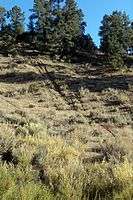 Negative environmental effects caused by a motorcycle to a portion of the Los Padres National Forest.
Negative environmental effects caused by a motorcycle to a portion of the Los Padres National Forest.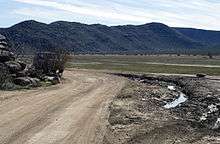 Damage that occurred when vehicles left the posted trail. Anza-Borrego Desert State Park.
Damage that occurred when vehicles left the posted trail. Anza-Borrego Desert State Park.
See also
- Amphibious vehicle
- Baja Bug
- Game viewer vehicle
- Mud bogging
- Ramp travel index
- Off road park
- Suspension (vehicle)
- Breakover angle
Further reading
References
| Wikimedia Commons has media related to Off-roading. |
- ↑ United States Forestry Service. "Willamette National Forest". Retrieved 19 May 2013.
- ↑ "Muddy Run Raceway Rules". muddyrunraceway.com. Retrieved 1 September 2016.
- ↑ US Gov't. "USFS". Retrieved 19 May 2013.
- ↑ http://www.downthunder.com.au/workshop/mechanical/Limited-Slip-Differentials-and-Differential-Lockers
- ↑ http://www.fs.fed.us/recreation/programs/ohv/
- ↑ http://www.sierraclub.org/policy/conservation/offroad.asp
- ↑ http://www.wilderness.org/OurIssues/ORV/index.cfm?TopLevel=Home
- ↑ Rice, Kathleen C. "National Collection of Imperiled Plants - Pholisma sonorae". Center for Plant Conservation. Retrieved 8 June 2012.
- ↑ "Mojave lizard may get protection; off-road vehicles are cited as threat". Los Angeles Times. 12 January 2008. Archived from the original on December 4, 2008.
- ↑ http://www.lvrj.com/news/13702907.html
- ↑ http://www.mnresponsiblerec.org/Library/reports/Off-roadvehicledamageinDuluth.htm
- ↑ http://www.fs.fed.us/r10/chugach/forest_plan/FEIS_VOLUME_1/chapter3_p1feis.pdf
- ↑ http://wilderness.org/content/addressing-ecological-effects-road-vehicles
- ↑ url=http://www.wildlandscpr.org/node/258
- ↑ http://www.ecy.wa.gov/pubs/0401007.pdf
- 1 2 Mojave’s Off-Highway Roads Found Illegal
- 1 2 Judge rejects federal plan for SoCal desert routes
- 1 2 3 Sahagun, Louis (September 30, 2009). "Judge rejects U.S. management plan for California desert". Los Angeles Times.
- ↑ http://fl.water.usgs.gov/cesi/rkg_publiclandindicator_proj.htm
- ↑ http://www.naturaltrails.org/pressroom/releases/2004/bos-rec-final.pdf
- ↑ http://www.ens-newswire.com/ens/jun2004/2004-06-15-10.asp
- ↑ http://www.peer.org/campaigns/publiclands/orv/index.php
- ↑ http://resourcescommittee.house.gov/index.php?option=com_jcalpro&Itemid=27&extmode=view&extid=151
- ↑ http://energy.senate.gov/public/index.cfm?FuseAction=Hearings.Hearing&Hearing_ID=ca2e6111-befb-b64a-8a55-3945b88b484e
External links
| Wikivoyage has a travel guide for Offroad driving. |
- Man-made erosion, The National Trust (UK)